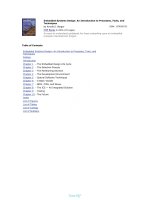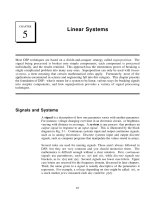Earth systems
Bạn đang xem bản rút gọn của tài liệu. Xem và tải ngay bản đầy đủ của tài liệu tại đây (1.35 MB, 23 trang )
Today: Lecture Overview
Prelude: What is Geology?
Nature of the scientific method
- Class discussion
Overview of Earth Systems
Origin of the Earth and Solar System
Nebular hypothesis
OUR COURSE’S WEBSITE
/>Note: NO “www”!!!
Prelude:
“And just what is Geology?”
Solid Earth
Interior of the
Earth is losing
heat.
Primary source
of heat:
Radioactive decay
Heat loss drives
convection, based
on density
differences
Hotter stuff is
lighter and rises
Cooler stuff is
denser and sinks.
Prelude: Earth’s internal structure
3 distinct divisions:
crust
Oceanic 0-6 km (“young”, < 180 m.y.)
Continental 0-34 km (older, up to 3.8 b.y.)
mantle
Upper 34-670 km
Lower 670-2900 km
core
Outer (liquid) 2900-5160 km
Inner (solid) 5160-6370 km
Prelude: Plate Tectonics
Earth’s dynamic interior and crust
Heat loss drives plate tectonics
Three types of plate boundaries
Prelude: Earth Systems
Solid Earth
Atmosphere
Hydrosphere
Cryosphere
Biosphere
Atmosphere
Blanket of gases surrounding the Earth
Protection from Sun’s heat & UV rays
Weather: due to exchange of energy
between Earth’s surface & atmosph.
between atmosph. & outer space
Strongly interacts w/ surface
Hydrosphere
Water portion of Earth
Oceans (most prominent)
71% of surface of Earth
Streams, lakes, glaciers, underground water
Atmosphere
Cryosphere
Icy portion of Earth’s crust
Glaciers
Permafrost and ground ice
Polar ice caps
Frozen polar seas
Water is the primary agent of crustal weathering
Biosphere
Earth’s Ecosystems
Earth’s biosphere occupies both the surface and
subsurface to depths of a few kilometers
Life occupies an extreme range of environments
Life strongly interacts with the atmosphere, the
hydrosphere and the solid earth to affect their
composition and long-term evolution (these
interactions are called ecology!)
Earth: The Living Planet
Most of the biodiversity on our planet is microbial!
The Three Domains of Life
Boiling mudpot, Yellowstone
Some extremes of life
Fungi and Plants
Plants consume carbon dioxide and produce oxygen
via photosynthesis. Most of the 21% oxygen in our
atmosphere derives from this process!
Fungi and and plants form symbioses called Lichens and
Mycorrhizae that alter rocks and produce soils.
Lichens
Mycorrhizae
Credit: INVAM
Credit: Sharnoff
Against a constant backdrop of gravity,
the atmosphere, hydrosphere and
biosphere interact with the rocks of the
Earth’s crust to break them down and
transport them to depositional basins
(e.g. the oceans) as sediment. The cycle is
renewed as internal processes of plate
tectonics create new crust and uplift
it to form mountain ranges.
Earth is one of nine planets comprising the Solar System
Earth
How did the Solar System form?
Earth Formation
Planets thought to
have formed:
At same time
From same
material as the
Sun
Nebular hypothesis
Solar system formed from giant cloud of mostly
hydrogen and helium, and a small percentage of heavier
elements.
Nebular Hypothesis:
States that the planets of
our Solar System were
formed by the “accretion”
of materials from a cloud
of gas and dust
called a solar “nebula”.
Collapse of the nebula under
its own gravity formed a
rotating disk around
a dense, central core of
material. This core
eventually became hot
enough to form the Sun.









